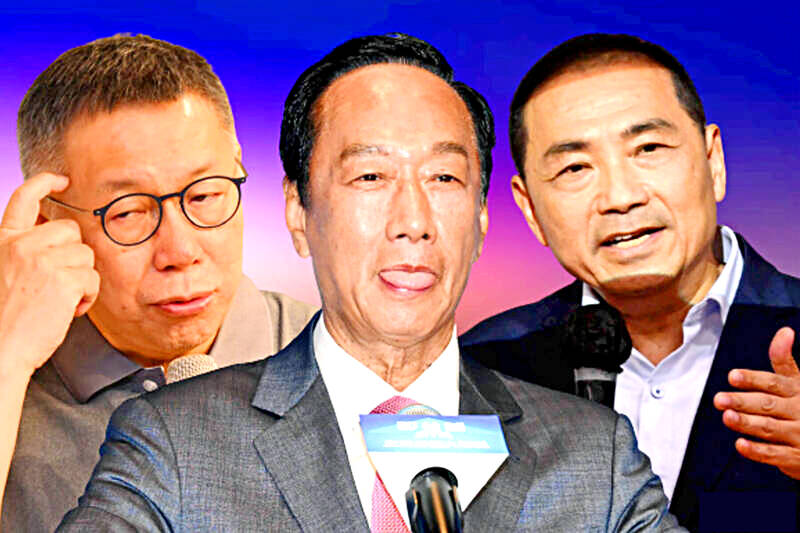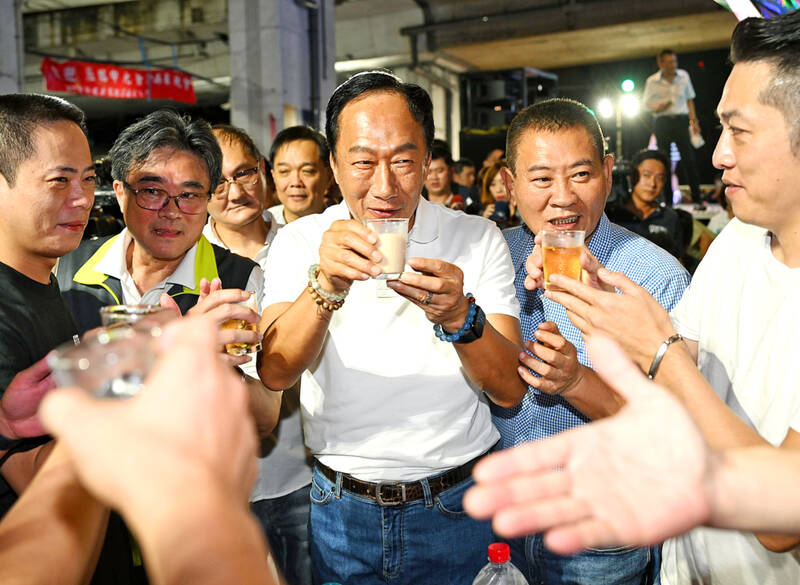Hon Hai Precision Industry Co (鴻海精密) founder Terry Gou (郭台銘) threw his hat in the presidential ring last week. Because he does not belong to a major party, he has to collect signatures from 1.5 percent of voters, or 290,000 people.
A million analyses are going to pour forth from the media, all which will amount to saying that Gou hurts the pro-China side by subdividing its minority vote even further, thus helping the pro-Taiwan side. Indeed, an interesting simulation of tactical voting in the election by longtime Japanese-Taiwan expert Ogasawara Yoshiyuki published by News Lens shows that Gou reduces Democratic Progressive Party (DPP) candidate William Lai’s (賴清德) threshold for winning to probably under 40 percent.
Gou will not merely divide the opposition more, but his constant nattering about China will also help the DPP by focusing attention on China policy, a DPP strength, instead of the DPP’s lackluster domestic performance.

Photo: Liberty Times
The more interesting question, posed by the very sharp scholar and commentator Sung Wen-ti (宋文笛),was why the Chinese Nationalist Party (KMT) keeps fracturing and tossing out multiple pan-blue candidates in every presidential election.
“It makes one wonder whether the ruling DPP enjoys a built-in advantage” he opined.
The answer to that is of course yes, it does. Things that happen repeatedly, like the multiplicity of people with KMT roots acting as candidates in elections, are structural problems.

Photo: Chang Chia-ming, Taipei Times
Indeed, Gou announced his run by alluding to this problem, saying that he was running to unite the opposition.
PRESIDENTIAL DEJA VU
A brief review of history. In the 1996 three KMT-linked candidates ran for president, against only one from the DPP. In addition to the far right more-KMT-than-the-KMT New Party, former Control Yuan president and longtime KMTer Chen Li-an (陳履安) ran as an independent and got nearly 10 percent of the vote. In 2000 there were five candidates, four of whom had KMT links, including former DPP chairman Hsu Hsin-liang (許信良), then aligned with the KMT, who received less than one percent of the vote.
In 2004 the pan-Blues were united, briefly, and came within a whisker of winning. In 2008 the KMT won convincingly, with no pan-blue rivals to cut into the party’s vote. In 2012 former KMTer James Soong (宋楚瑜) took less than 3 percent of the vote, but managed to reach nearly 13 percent in 2016. He would go on to take less than 5 percent in 2020. His party is not fielding a candidate in this election, but it, along with the New Party, still exists.
Indeed in the 2020 election the New Party nominated Yang Shih-kuang (楊世光), who complained that only women supported independence. His nomination was withdrawn in November of 2019 when he failed to gain enough signatures to appear on the ballot.
Yang’s failure shows how the stringent election rules that require that a candidate represent a major party or collect 1.5 percent of voters’ signatures help the KMT by cutting down on the number of ex-KMT politicians who can stand for president against it. This restriction helps foster the illusion that the blue camp is more united than it actually is. Gou has both the fame and funds to climb that fence.
As the political organization of a colonial elite, the KMT historically had two major functions in Taiwan: managing the links between the colonial one-party state and local politicians, and acting as the custodian of Mainlander identity. Note that neither of these conflicting functions involves winning elections.
Historically, the links between the KMT and local Taiwanese politicians are not mediated by some shared political identity, but by flows of money from the one-party government and party center. When those benefits cease or when local politicians feel slighted, local politicians will look for other options, easy for them since so many have independent local power bases.
This is a structural feature of KMT control, meaning that local elections often repeat the confusion at the top, with elections for county chief offering a melange of former KMT politicians turned independent running against each other and the KMT.
When this phenomenon occurred at the national level and Soong left the KMT in the 2000 election, he had spent the previous decade as Taiwan “provincial” governor and had visited nearly every township in the nation, cultivating local links.
MAINLANDER IDENTITY
The other issue is the KMT’s function as Church of the Mainlander identity. The purity struggles over the Mainlander identity invites politicians to spin off to its right whenever they feel the party has lost its theological way. Thus the New Party was originally born (as the Chinese New Party, which avowed it supported the ideals of Sun Yat-sen, 孫逸仙).
The flip side of Sung’s perspicacious question is why doesn’t the DPP do this? The answer is that while the KMT is an organization with a label on it saying WARNING: MAY CONTAIN PARTY-LIKE SUBSTANCE, the DPP is an actual political party, consciously founded as one, and unlike the KMT, without Leninist roots. It embraces a number of identities under the rubric of “Taiwaneseness.” Nor is the DPP the custodian of that identity, which is found in all Taiwan parties. Hence, no would-be independent politician can argue that they are more Taiwanese than the DPP, even to themselves.
There is nothing in the DPP remotely like the colonial relationship between the Mainlander elites at the KMT and the Taiwanese local politicians in the KMT. Nor is there a really strong rival pro-Taiwan party a DPP politician can find refuge in. A disgruntled DPPer is almost always better off waiting for a rival to move up or out, than leaving.
Gou may actually unite the opposition parties, but more by blunting their attempts to distinguish themselves from each other by burying them in rhetoric about China and peace than by bringing them together in any positive way.
Remember, that New Taipei City Mayor Hou You-yi (侯友宜) and Taiwan People’s Party Chairman Ko Wen-je (柯文哲), both candidates in next year’s presidential election, have to run to gain subsidies from the government for their parties. At present those subsidies are keeping the KMT alive, as longtime Taiwan politics observer Courtney Donovan Smith has pointed out in recent work, since many of its assets are frozen.
In the end, many are already privately observing, the election is unlike to feature three blue camp candidates. Somebody is going to make a deal, or drop out. And Gou has no party in need of subsidies under him.
Not that it matters. With the KMT, “all this has happened before, all this will happen again.”
Notes from Central Taiwan is a column written by long-term resident Michael Turton, who provides incisive commentary informed by three decades of living in and writing about his adoptive country. The views expressed here are his own.

Oct. 27 to Nov. 2 Over a breakfast of soymilk and fried dough costing less than NT$400, seven officials and engineers agreed on a NT$400 million plan — unaware that it would mark the beginning of Taiwan’s semiconductor empire. It was a cold February morning in 1974. Gathered at the unassuming shop were Economics minister Sun Yun-hsuan (孫運璿), director-general of Transportation and Communications Kao Yu-shu (高玉樹), Industrial Technology Research Institute (ITRI) president Wang Chao-chen (王兆振), Telecommunications Laboratories director Kang Pao-huang (康寶煌), Executive Yuan secretary-general Fei Hua (費驊), director-general of Telecommunications Fang Hsien-chi (方賢齊) and Radio Corporation of America (RCA) Laboratories director Pan
The consensus on the Chinese Nationalist Party (KMT) chair race is that Cheng Li-wun (鄭麗文) ran a populist, ideological back-to-basics campaign and soundly defeated former Taipei mayor Hau Lung-bin (郝龍斌), the candidate backed by the big institutional players. Cheng tapped into a wave of popular enthusiasm within the KMT, while the institutional players’ get-out-the-vote abilities fell flat, suggesting their power has weakened significantly. Yet, a closer look at the race paints a more complicated picture, raising questions about some analysts’ conclusions, including my own. TURNOUT Here is a surprising statistic: Turnout was 130,678, or 39.46 percent of the 331,145 eligible party

The classic warmth of a good old-fashioned izakaya beckons you in, all cozy nooks and dark wood finishes, as tables order a third round and waiters sling tapas-sized bites and assorted — sometimes unidentifiable — skewered meats. But there’s a romantic hush about this Ximending (西門町) hotspot, with cocktails savored, plating elegant and never rushed and daters and diners lit by candlelight and chandelier. Each chair is mismatched and the assorted tables appear to be the fanciest picks from a nearby flea market. A naked sewing mannequin stands in a dimly lit corner, adorned with antique mirrors and draped foliage

The election of Cheng Li-wun (鄭麗文) as chair of the Chinese Nationalist Party (KMT) marked a triumphant return of pride in the “Chinese” in the party name. Cheng wants Taiwanese to be proud to call themselves Chinese again. The unambiguous winner was a return to the KMT ideology that formed in the early 2000s under then chairman Lien Chan (連戰) and president Ma Ying-jeou (馬英九) put into practice as far as he could, until ultimately thwarted by hundreds of thousands of protestors thronging the streets in what became known as the Sunflower movement in 2014. Cheng is an unambiguous Chinese ethnonationalist,